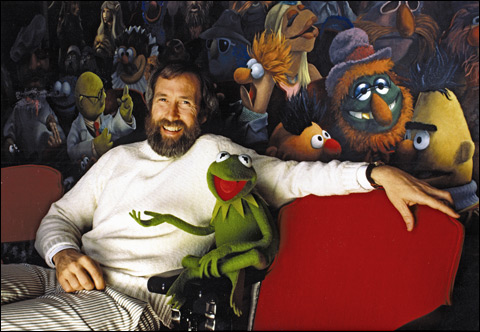
ENTERTAINER Jim Henson’s inspiration came from traditional European puppetry by way of Mickey Mouse, TV variety shows, vaudeville, and Rocky and Bullwinkle. |
In the beginning, there was Kermit. Not Kermit the Frog — not just yet. That would come nearly 15 years later. At this point, he was just Kermit, without the webbed feet or the spiky collar. He was one of the hand-and-rod puppets in Jim Henson’s television show Sam and Friends, which debuted in Washington, DC, in 1955. Featuring five-minute episodes of goofy, bug-eyed puppets lip-synching to pop songs or parodying other TV shows, Sam was scheduled as a lead-in each day to the station’s evening news and the Steve Allen-hosted Tonight Show.By the mid 1960s, these prime spots had landed Henson’s Muppets appearances on The Tonight Show, The Today Show, and The Ed Sullivan Show. Then on November 10, 1969, Sesame Street debuted, and it became a landmark of children’s educational television. One of its key insights was to give shows the pep and pace of commercials.
Meanwhile, in Germany in the 1950s, Peter Schumann was trying to lead a dance troupe and making masks and sculptures, with mixed success. By 1962, he’d moved to New York and was performing masked dances of death and grim papier-mâché puppet shows about war. His troupe, dubbed Bread and Puppet Theater by 1963, was one of the great experimental theaters of the 1960s, a theater of large grotesque puppets and expressionist masks for ritual pageantry, anti–Vietnam War street protests, and some clowning.
Henson (1936-’90) and Schumann (born 1934 and still active) became the most influential American puppeteers since World War II — and among the most important artists of the past century. Henson’s style of simple fleece, foam, and ping-pong-ball-eyed puppets has become ubiquitous in America because so many budding puppeteers saw them on TV. Schumann’s giant papier-mâché pageantry has become the archetype for street protests and seasonal public spectacles — often created by puppeteers who’ve apprenticed with him.
Two exhibits now on view offer us a chance to compare their art: “Jim Henson’s Fantastic World” at the National Heritage Museum in Lexington and “Extraordinary: Puppetry, Storytelling & Spirit” at the New Art Center in Newtonville. The latter features Bread and Puppet as well as traditional Indian shadow puppets, toy theaters, and folk-tale paintings and scrappy assemblage puppets by Ashley Bryan, Jeff Sias, and Donald Saaf and Julia Zanes of the Bluebird Theatre.
“Jim Henson’s Fantastic World,” which was organized by the Jim Henson Legacy (a Henson-affiliated organization dedicated to promoting his work) and the Smithsonian Institute, covers the breadth of his career. Muppets Kermit, Rowlf, and Ernie and Bert are here, plus Cantus and Gobo from Fraggle Rock. But the emphasis on drawings over puppets (just 14, and almost all later copies rather than early prototypes) makes the show feel slim.